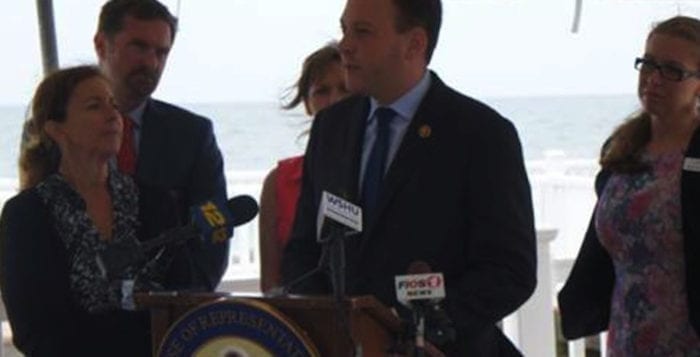The Long Island Sound shouldn’t be used as a “dumping ground.”
That’s what U.S. Rep. Lee Zeldin (R-Shirley), a member of the House Transportation and Infrastructure Committee and Long Island Sound Caucus, had to say while overlooking the Long Island Sound at Cedar Beach in Mount Sinai on July 29. While there, he called on the Environmental Protection Agency to keep its commitment to permanently close the Eastern Long Island Sound disposal sites. The congressman also called on the EPA to expedite the process to phase out the Western and Central Long Island Sound disposal sites.
“The Long Island Sound shouldn’t be a dumping ground, especially when there are many viable alternatives to open-water dumping, including recycling and safe disposal on land,” he said.
On April 27, the EPA issued a proposed rule, the “Ocean Disposal; Designation of a Dredged Material Disposal Site in Eastern Region of Long Island Sound; Connecticut (81 FR 24748),” which would continue open water dumping of dredge waste in the Eastern Long Island Sound for up to 30 years, despite the agency previously committing to close both disposal sites, Cornfield Shoals and New London, by Dec. 23 of this year. Last month, on June 30, Zeldin sent a letter to the administrator of the EPA opposing the proposed rule. On July 7, the EPA announced a final rule that continues open water dumping at the Central and Western Long Island Sound dump sites, while phasing these sites out over the next 30 years.
“The EPA should immediately reverse this proposal and honor their previous commitment to permanently close the Eastern Long Island Sound disposal sites by the end of this year.”
—Lee Zeldin
“This proposal is unacceptable,” Zeldin said. “The EPA should immediately reverse this proposal and honor their previous commitment to permanently close the Eastern Long Island Sound disposal sites by the end of this year. We need a much more aggressive path to phasing out open water dumping at these sites in the Long Island Sound.”
When the Eastern Long Island Sound disposal sites were created by the EPA in 2012, it was explicitly for “short-term, limited use,” but now the agency is moving to keep one or more of these sites open for up to 30 years. Zeldin expressed his support for phasing out open water dumping at these sites in the Long Island Sound over a period of five to 10 years, and expressed major concerns with ecological impacts on the Long Island Sound.
“The Long Island Sound, an EPA designated Estuary of National Significance and one of the nation’s most populated watersheds, is a cultural and natural treasure that provides a diverse ecosystem with more than 170 species of fish, over 1,200 invertebrates and many different species of migratory birds,” he said. “The Sound is also essential to the everyday economy and livelihood of millions of Long Islanders. Over the years, water quality on Long Island has suffered severely from issues such as pollution and overdevelopment.”
Congressman Zeldin was joined by local elected officials and environmental groups who backed up his argument and supported his proposals.
“I stand with New York’s state and federal elected officials and administrators in condemning this poor excuse of a document in the strongest terms,” said Brookhaven Town Supervisor Ed Romaine. “Just in the last few years we have started to enjoy the benefits of a cleaner Long Island Sound. I cannot understand why the EPA would or should allow this plan to undo the hard and expensive work that has been done over the last two decades to restore the Long Island Sound. We simply must do better.”
Councilwoman Jane Bonner (C-Rocky Point) agreed.
“The Town of Brookhaven is doing so much to keep the Long Island Sound and our other waterways clean, and this disposal site expansion plan is a real threat to our progress,” she said.
Executive Director of Citizens Campaign for the Environment, Adrienne Esposito, said the Eastern Long Island Sound is the most biologically diverse portion of the nationally important estuary.
“Continuing the use of our Sound as a dump site stymies restoration efforts,” she said. “It prevents the advancement of a long-term program for beneficial reuse of dredged materials.”






